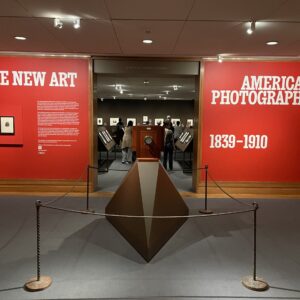JTF (just the facts): A total of 32 photographs, framed in black and unmatted, and hung against white walls in both gallery spaces. (Installation shots below.)
The following works are included in the show:
- 7 archival pigment prints, 2003, 2004, 2008, 2009, 2021, 2024, sized 33×50 inches, in editions of 15+3AP
- 3 archival pigment prints, 2000, 2002, 2003, sized 20×50 inches, in editions of 15+3AP
- 1 archival pigment print, 2011, sized 30×30 inches, in an edition of 20+3AP
- 21 archival pigment prints, 2000, 2006, 2007, 2008, 2011, 2012, 2013, 2015, 2021, 2022, 2023, 2024, sized 20×30 inches, in editions of 20+3AP
Comments/Context: The relationship between photojournalism and fine art photography isn’t always an easy or obvious one. Not all photojournalism is ever considered fine art photography and certainly not all fine art photography can plausibly be called photojournalism, but in the middle, there is an area of overlap where the two circles actually do merge. In this shifting in-between ground, the context and presentation are in flux – an image made on commission for a newspaper or magazine (and originally distributed on paper, with an explanatory caption, or now digitally) is shown in a gallery space or museum. More importantly than the physical placement of the print, the reading of the image is fundamentally transformed, where the central news, politics, humanitarian, or broader documentary rationale behind the picture is disrupted, in favor of a conceptual or aesthetic engagement that evaluates the image with different criteria. Often this re-seeing is facilitated by the slow passing of time; once the intensity of a given moment has passed far enough into the distance, a photograph that was once news can be more easily reconsidered as a stand alone art object.
This chronological repositioning has expanded the way we think about plenty of photographers, from 20th century icons of photojournalism like Henri Cartier-Bresson, Margaret Bourke-White, and W. Eugene Smith (to name just a few), to more contemporary names still out in the field following the events of the day. With two Pulitzer Prizes and a MacArthur Fellowship already in her shoulder bag, Lynsey Addario certainly needs no introduction to those following 21st century photojournalism; her consistent work for The New York Times and National Geographic over the past three decades has cemented her place in the industry. And yet, over in the adjacent world of fine art photography, Addario’s name is much less well known and appreciated. Following up on a retrospective exhibition of her work at the SVA Gallery (in New York) in 2022, this introductory survey in gallery show form aims to widen her reach.
One of the intriguing things to think about for a successful photojournalist like Addario who is actively making the crossover to fine art is which images from her vast career in conflict zones around the world might make the most sense in a gallery or museum setting. In one manner, the straightforward communication that a picture of the scene on the ground in a place like Afghanistan, South Sudan, Somalia, or Ukraine might deliver might also be less durably compelling than a more elusive or mysterious image from that same roll of film – visual “legibility” isn’t necessarily as critical for fine art as for news making, and in some cases, it seems likely that images that were rejected for being too obscure or esoteric for a newspaper might actually be the very images that function best when delivering a formal, compositional, or emotional message that is less literal. In this way, the editing process actually requires more nuance and creativity than we might imagine.
This show gathers together images that are both “landscapes” and “portraits”, although those monikers are perhaps more rigidly separate than her pictures actually deliver; in many cases, Addario offers us figures in a landscape, and it is largely their relationship to that particular place that gives the pictures their energy. Resonant gestures and movements lie at the heart of many of Addario’s strongest and most memorable compositions. Congolese men fight against splashing river water in the search for rough diamonds, their arms tensed against the force of the water. The black robe of an Iraqi woman flutters in the wind like a billowing cape, the grim smoke in the sky coming from a fire at a nearby gas factory. An opposition solider stands atop two pillars in search of Libyan government soldiers, his spread legs an echo of an number of jumping body images from across the history of the medium. And a woman’s otherwise solemn visit to the grave of her relatives in Afghanistan is punctuated by a passing of a man with a huge load of colorful balloons.
While Addario works in both black-and-white and color, it’s clear from this edit of her work that her eye for color, as both an overall mood setting device and as a potential splash of compositional energy, is well developed and sophisticated. When separated from their narrative and geographic contexts, many of her images can be read as elegantly conceived color stories: Sudanese soldiers in green and yellow, set against a misty purple sky; a stranded young Afghan woman in blue (in labor, no less) backed by a deep blue sky of the same color; a young Sudanese boy in a red jersey, fleeing to safety by poling his way through a swamp of green lilypads; the hazy dark yellow sky of a drought-ridden area of northern Afghanistan; and a Syrian woman in a red coat, smoking in the twilight of the evening in Lebanon (where she is a refugee from the fighting in her home country).
Of course, Addario uses faces and facial expressions to tell some of her most poignant visual stories. A young Afghan bomb victim stares out with weary watery-eyed intensity, his face covered with bandages. Dark scabs and wounds cover the face of a Ukrainian man caught in a Russian missile attack. Exhausted desperation writhes on the faces of migrants at the end of Darien Gap crossing in Panama. And tender care enlivens the face of a Ukrainian mother tending to her newborn in a basement maternity ward. But even when the faces are too far away to be recognizable, or the land itself is Addario’s subject, her images still feel full of rich emotion and conflicted pathos. A boat on the rough seas that hopeful migrants traverse in their journey northward looks like a turbulent scene out of a Winslow Homer painting, albeit with a more contemporary resonance. A recently shelled kindergarten room in Ukraine mixes the playful innocence of childhood and the violent rubble of war. And a seething view of a California wildfire places a smoky hellscape behind a veil of silhouetted wildflowers.
There is a near constant sense of intensity in this edit of Addario’s work, which really never lets up. The only photograph that seems to step out of the moment to explore the complexities of found compositional layers is an early black-and-white street scene from Pakistan, where clusters of passing bodies in the streets (including one man carrying a table above his head) are echoed by faces on a movie marquee above, creating a panorama of humanity seeing and watching. But this image is a relative outlier in terms of Addario allowing narrative to slip away in favor of aesthetic construction; perhaps there are more images like this one in some other edit of her long career, but as seen here, compact single frame storytelling generally comes first.
I’m guessing that for an in-demand photojournalist like Addario, with any number of flashpoint conflicts around the globe begging for her attention, the idea of spending time massaging an art world persona and body of work likely feels mildly misguided – there just isn’t time for this kind of stuff when the world is on fire (which it always is). But when (with the help of gallery partners) she does finally get around to further tuning her archive and producing more single subject photobooks and exhibitions, I expect the institutional response will be strong. This sampler is compelling evidence of not only hard hitting photographic compassion, but of an intuitive sense for how a photograph can tell a durably powerful story. I’m sure that the more Addario aims her attention at packaging up her images in ways that will make them easier for collectors to understand and digest, the more she will find the photographic art world ready to embrace her.
Collector’s POV: The prints in this show are priced at $4000, $6500, or $7500 based on size, with most of the images available in two sizes (small and large). Addario’s work has little secondary market history at this point, so gallery retail remains the best option for those collectors interested in following up.


























Thank you for welcoming Lynsey’s world into New York.